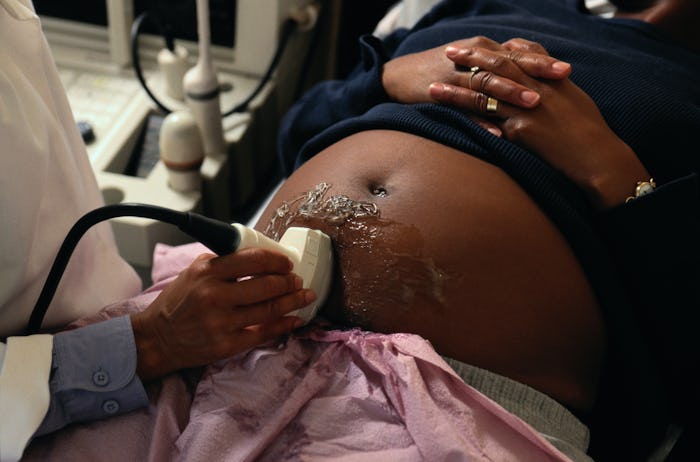At The Doc

What Do Doctors Look For In Anatomy Scans? Experts Explain
Midway through my first pregnancy, I was delighted to learn that I was indeed expecting a son. Seeing his tiny fingers wave to me through a grainy ultrasound during my anatomy scan was life-changing. But, aside from gender, just what do doctors look for in anatomy scans? Even though my status as a "boy mom" was revealed that day, a child's sex organs are definitely not the only thing physicians look at during an anatomy scan.
As exciting and precious as those first glimpses of your growing babe are, anatomy scans serve an incredibly important purpose to check on the growth and development of your baby. Dr. Neetu Sodhi, D.O., who specializes in obstetrics at Bloom Obstetrics and Gynecology in Southern California, tells Romper that an anatomy scan is essentially an "evaluation of fetal growth and appropriate anatomical development."
So, how does this happen? If you've never had an anatomy scan before, one pro tip is to wear pants and a loose-fitting top. Since these scans are typically performed transabdominaly, the ultrasound wand will scan your baby from the outside of your belly. (Otherwise, you may end up laying on a cold table with a dress pulled up around your chest. Been there, done that.) During this time, Sodhi says that the "heart, kidneys, brain, spine, stomach, bladder and sex organs will be evaluated from different angles," and that "the face and spine and limbs will also be evaluated along with the fetal heart rate."
Dr. Rachel Borton, director of the Family Nurse Practitioner (FNP) online program and assistant professor of nursing at Bradley University, tells Romper, "While insurance can factor into how often ultrasounds are completed during pregnancy, typically three are scheduled." There's one for each of the three trimesters, with the anatomy scan being the middle one. "During the second trimester, between 20 to 24 weeks, a transabdominal ultrasound will be completed to determine that anatomy is developing as anticipated and no organ abnormalities are present, also the sex of the baby is determined at this time," she explains.
While it may seem obvious that a doctor would examine how a baby's organs are developing, they also use anatomy scans to check the functions of the mother's womb as well. This could include "measurements of the amniotic fluid and location of the placenta," Sodhi tells Romper.
During the scan, physicians look for different markers and measurements to determine whether or not the baby is developing as they should, and that mom's womb is healthy. "There are specific findings — hard and soft markers — that could indicate a higher chance of the fetus having a chromosomal abnormality," Sodhi explains. "Congenital defects occur in about 3% of all births, and a detailed anatomy scan will pick up approximately 75% of them."
Anatomy scans can be an incredibly emotional experience, especially if things aren't taking shape the way they should, but your doctor's job is to guide you through the next steps if any abnormalities show up.
"As you can imagine, the skill of the individual completing the ultrasound heavily weighs into the accuracy of the ultrasound, but I think most providers will agree that while no test is 100% accurate, assuming you have a fairly skilled ultrasound technician or provider completing the scan, the ultrasound will be fairly close to that accuracy percentage," Borton tells Romper. "And of course, any abnormality identified would be followed up with further testing to confirm.
It is definitely important for your doctor to know that your baby is developing properly and work through any potential issues, but seeing your little one on an ultrasound screen is something that can also bring expectant parents so much joy. So even though it can be intense and nerve-racking, try to relax and soak up every single moment.
Experts:
Dr. Neetu Sodhi, D.O., obstetrician-gynecologist at Bloom Obstetrics and Gynecology
Dr. Rachel Borton, director of the Family Nurse Practitioner (FNP) online program, assistant professor of nursing at Bradley University
This article was originally published on